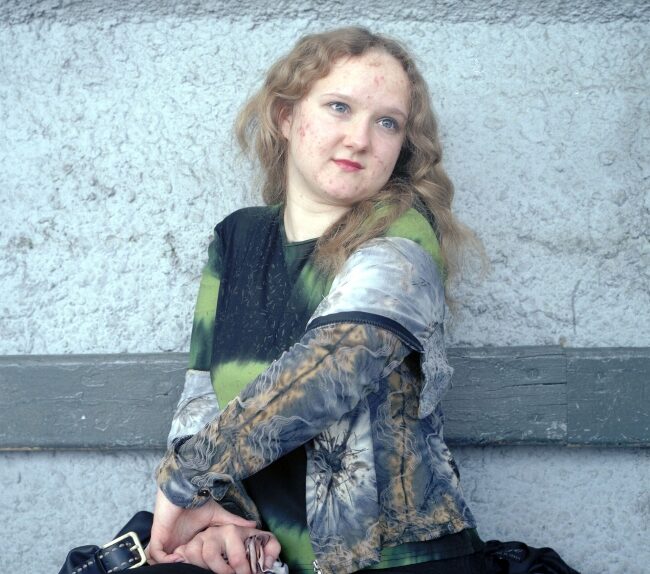In the middle of the 17th century the Dutch Republic gained its independence from Spain. The Dutch quickly became a major seafaring and economic power, the first thoroughly capitalist country in the world, and one of the most innovative centers of culture. A new European social phenomenon emerged: the middle-class elite. It was no longer necessary to be born to royalty to have power; merchants could shape the course of a nation.
One result of this unprecedented burst of wealth and shift in power was a concomitant shift in Dutch art. The nouveau-riche wanted to celebrate themselves. Dutch artists, not surprisingly, quickly became skilled at portraiture. Three hundred and fifty years later, Dutch artists still retain an affinity for portraits. One of the people perpetuating that tradition is Hellen van Meene.
She was born in 1972 in the town of Alkmaar in the province of North Holland. For her fifteenth birthday, her mother gave her a small pink camera. She did what most 15 year old girls would do; she started taking photographs of her friends. Twenty years later van Meene has traded in her little pink camera for a hefty Rolleiflex 2.8F, but she still lives in Alkmaar and she’s still taking photographs of 15 year old girls.
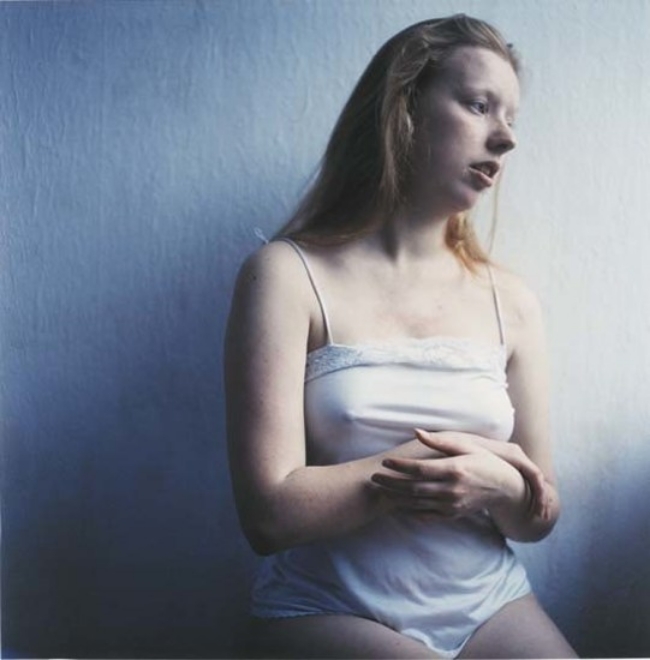
At the age of eighteen van Meene attended the Rietveld Academy in Amsterdam, a school specializing in design and the visual arts. Not surprisingly, she elected to study photography. From the beginning she knew she wanted to make portraits. Van Meene is fascinated by the variety of faces. Not just any faces, though. She doesn’t seem particularly interested in standard beauty–neither the modern concept of beauty or the more classical notion. Her interest is in incipient beauty; beauty that’s just beginning to exist.
Many–perhaps most–of her portraiture subjects are ordinary girls/young women from her neighborhood in Alkmaar. They’re not models in the commercial sense. They could be said to have ‘imperfect’ faces and ‘flawed’ bodies; they may have acne, they might have bruises, they could have freckles. They’re probably not be dressed stylishly, their make-up might be awkwardly applied. Van Meene describes her models in this way:
She’s just a girl who’s a bit too chubby, a bit giggly, a bit nervous and insecure. So you would probably walk by easily, as there are thousands of those girls who don’t believe in themselves… It’s too easy to make a photo of an insecure girl. I mean, there’s nothing in it. It’s much more of a challenge to take an insecure girl and change her into Queen Elizabeth.
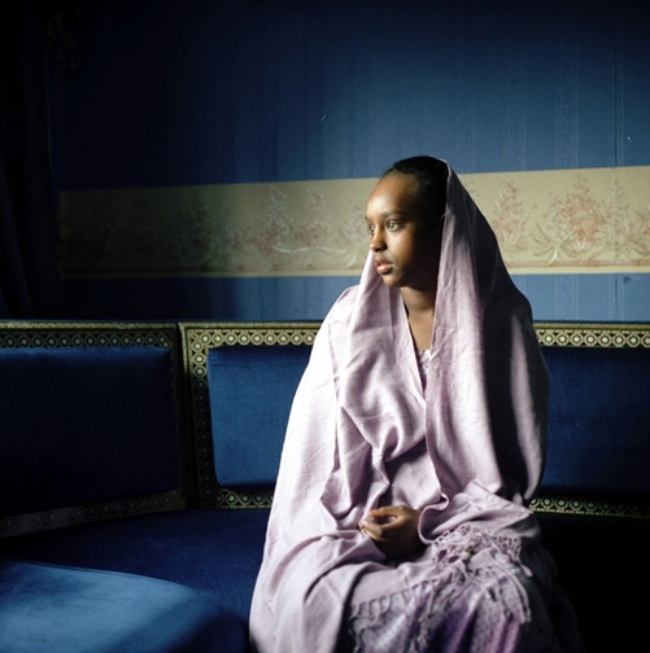
That’s what van Meene is after, that transformation. To get that, she forces herself to work within certain very tight parameters. She uses only natural light, she uses only film, and she restricts herself to rolls of twelve exposures. Those constraints, van Meene says, require her to work more carefully to get the image she wants.
She prefers natural light because she feels studio lighting is too perfect. Natural light demands more concentration, requires more attention paid to the subject’s face and pose, less attention given to the mechanics of lighting. The fact that natural light can change in an instant forces her to be more alert to the moment.
Natural light forces you to concentrate totally on your surroundings and on your model, you have to look really closely to the model. See how the light approaches her. Is it soft on her skin? Or does it make things really harsh?
Similarly, by limiting herself to film and to rolls of twelve exposures, van Meene is forced to be more careful. She suggests the inability to get the sort of immediate feedback provided by digital cameras makes her more meticulous in arranging the shot. By relying on rolls of twelve exposures, she must give greater attention to making the subject feel comfortable. If she shoots too quickly she will disrupt the flow of the portrait session by having to stop and change film. She’s not averse to changing film during a session; she simply wants to be selective about when she does it.
There is a seeming contradiction in van Meene’s work process. The equipment limitations she imposes on herself means she must work more slowly and more carefully, but at the same time the limitation of natural light means she must be more alert and more spontaneous. It’s a sort of photographic high wire act. The portraits that result from it are proof that it works. At least for her.
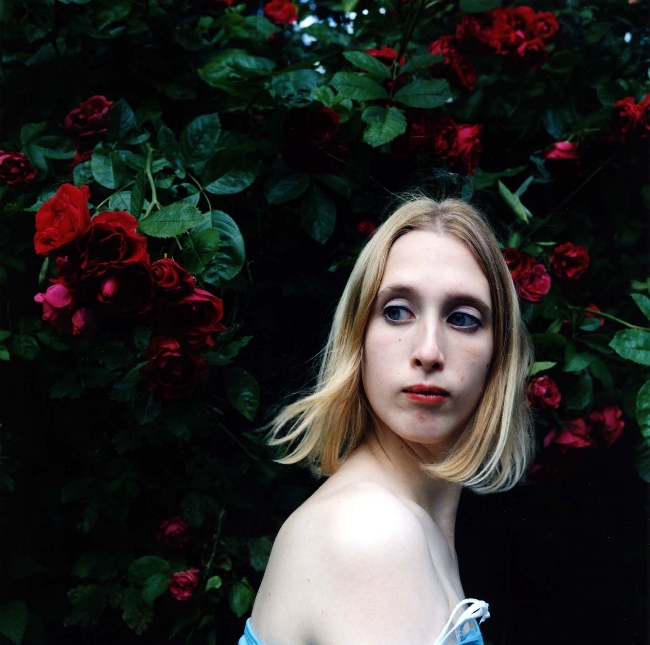
The working style of van Meene is an equally dizzying confluence of pre-visualization and improvisation. She often knows what she wants from the final photograph before she shoots it. Whenever possible she selects the setting, provides the props, and chooses the subject’s clothing. She decides how the subject will pose.
I look for a certain mood in the pictures, in which the girls almost figure as actors. As a matter of fact I treat my models as objects which you can direct and guide…I arrange everything, to the smallest detail, such as the nail polish on their fingers.
In yet another contradiction, though, Van Meene reduces her control over the process by having the subjects dress themselves and apply their own make-up. Not does she try to ‘touch up’ the way they’ve dressed.
Once the session begins van Meene is vulnerable to the equipment limitations she has placed on herself and is at the mercy of the ungovernable light. She frequently has to re-pose the subject to get the light she wants. She has to work while the light is good, but not so quickly that she disrupts the flow of the session. By mixing measures of control with unpredictability, she is able to produce images in which it is impossible to determine whether they are staged or spontaneous. In a way, that’s perfectly appropriate; the lives of girls at that age are also balanced between being theatrically staged and spontaneity.
Van Meene extends her distinctive style into the darkroom. After a great deal of experimentation, she leans toward more cyan when printing her negatives. The result is a cooler image that she finds more painterly. A warmer image may make the subject more attractive, but van Meene isn’t interested in creating portraits of generically attractive young girls. Her interest is in revealing what is individually and singularly attractive, but rarely observed.
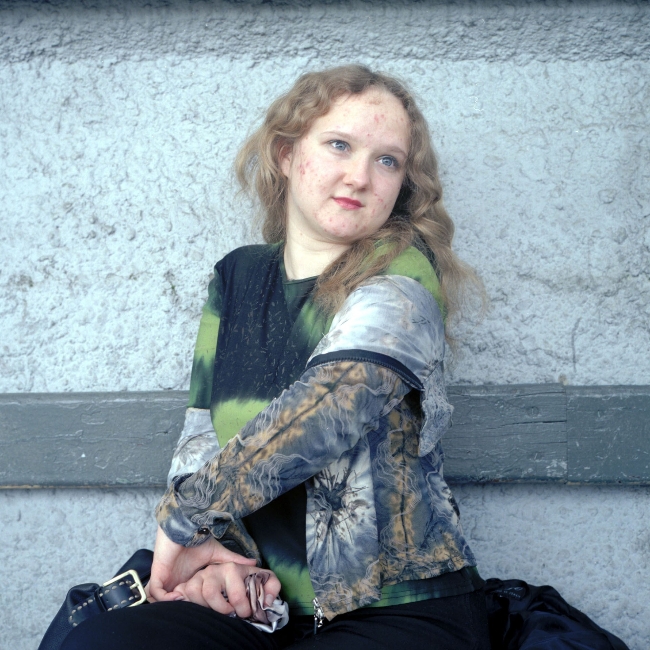
Perhaps the most intriguing aspect of Van Meene’s portraiture is that she doesn’t think of them as portraits at all.
[T]hey’re not really ‘portraits’. It’s not that I am aiming to make a precise document of the person in front of me. It’s rather more like a translation of someone I see in front of me, and whom I translate into something different.
And yet the echoes of earlier Dutch portrait painters are clearly visible in van Meene’s work. Despite the modern settings and clothing, her photographs often have a rather anachronistic appearance. The echoes are there, but only the echoes. Where traditional Dutch portraiture grew out of the desire of the newly rich to display their wealth and social standing, van Meene’s portraits reveal the ordinary person in ordinary settings. In doing so, she finds undiscovered beauty.

